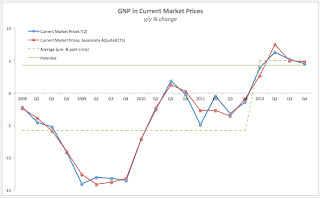I covered the headline numbers and trends for the GDP and GNP in previous two posts: here and here. Now, onto some more detailed analysis.
Remember, from the very beginning of the crisis, Irish and Troika leaders have been incessantly talking about the 'exports-led recovery'. Position on this blog concerning this thesis consistently remained that:
Remember, from the very beginning of the crisis, Irish and Troika leaders have been incessantly talking about the 'exports-led recovery'. Position on this blog concerning this thesis consistently remained that:
- Exports growth is great, but
- Exports growth is unlikely to be sufficient to lift the entire economy, and
- Exports growth projections were unrealistic, while
- Exports re-orientation toward services, away from goods was less conducive to delivering real growth in the economy.
Q1 2013 data continues to confirm my analysis.
In Q1 2013, based on real valuations (expressed in constant market prices),
- Exports of Goods & Services shrunk 6.47% q/q and fell 4.09% y/y. This compares to +1.19% q/q growth in Q4 2012 and +1.28% expansion y/y. Compared to Q1 2011, when the current coalition took over the reigns in the Leinster House, total exports of goods and services are down 0.88% in real, inflation-adjusted terms. Troika sustainability projections envisioned growth of over 6% over the same period of time.
- Imports of Goods and Services showed pretty much the same dynamics as exports in both Q4 2012 and Q1 2013, but owing to sharper contractions in 2011-2012 these are now down 4.34% compared to Q1 2011.
- Exports of Goods fell in Q1 2013 by 3.83% q/q and 9.37% y/y, while there were declines of 2.68% q/q and 2.33% y/y in Q4 2012.
- Exports of Services were down 8.75% q/q but up 1.27% y/y in Q1 2013, and these were up 4.77% q/q and 4.63% y/y in Q4 2012.
- Trade Balance in Goods and Services fell 4.96% q/q and was down 3.63% y/y in Q1 2013, with Q4 2012 respective changes at -15.91% q/q and +0.98% y/y. Compared to Q1 2011, trade balance is up 15.91%
- Trade Balance in Goods was down 6.63% q/q in Q4 2012 and this deteriorated to -10.73% growth in Q1 2013. Y/y, trade balance in goods contracted 0.05% in Q4 2012 and shrunk 10.59% in Q1 2013. On Q1 2011, trade balance in goods is down 14.04%.
- Trade Balance in Services fell from EUR1,130mln in Q3 2012 to EUR132mln in Q4 2012 before improving to EUR601mln in Q1 2013. In Q1 2012 the balance stood at EUR28 million.

















































